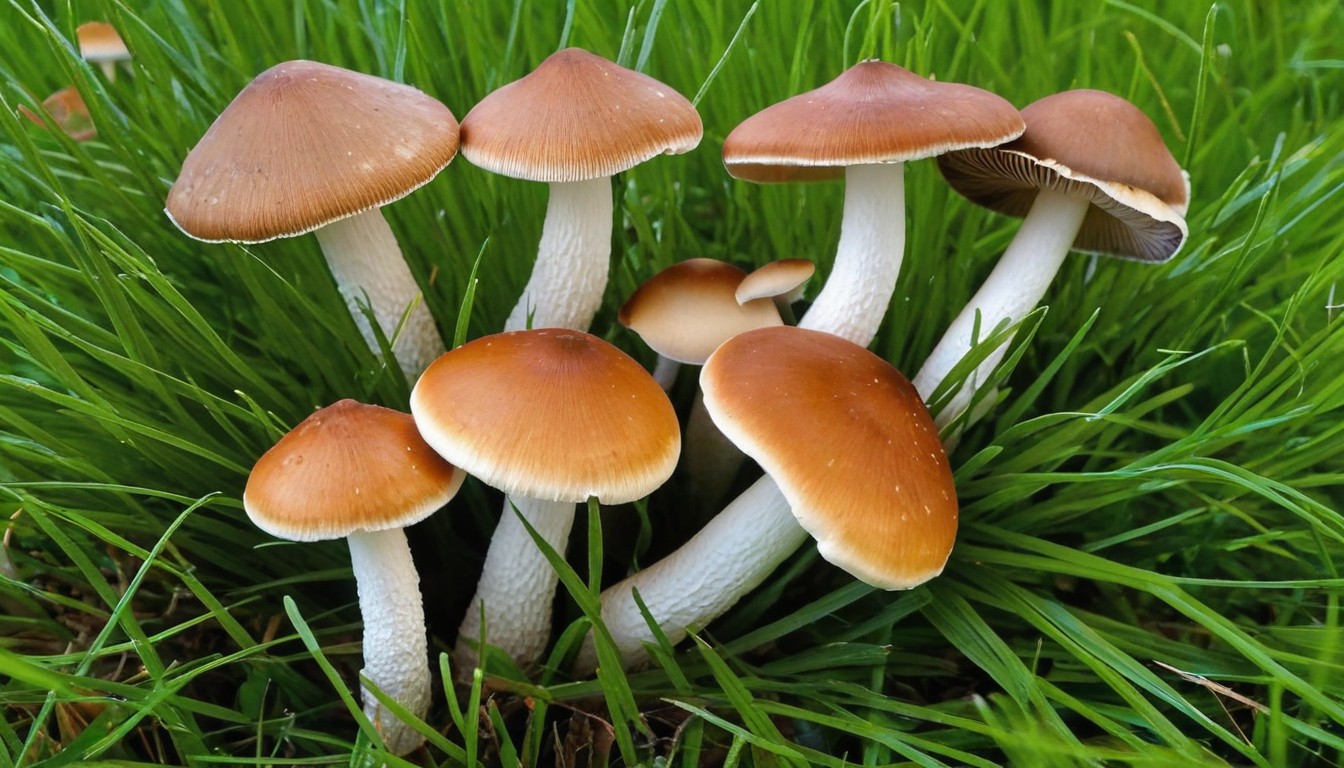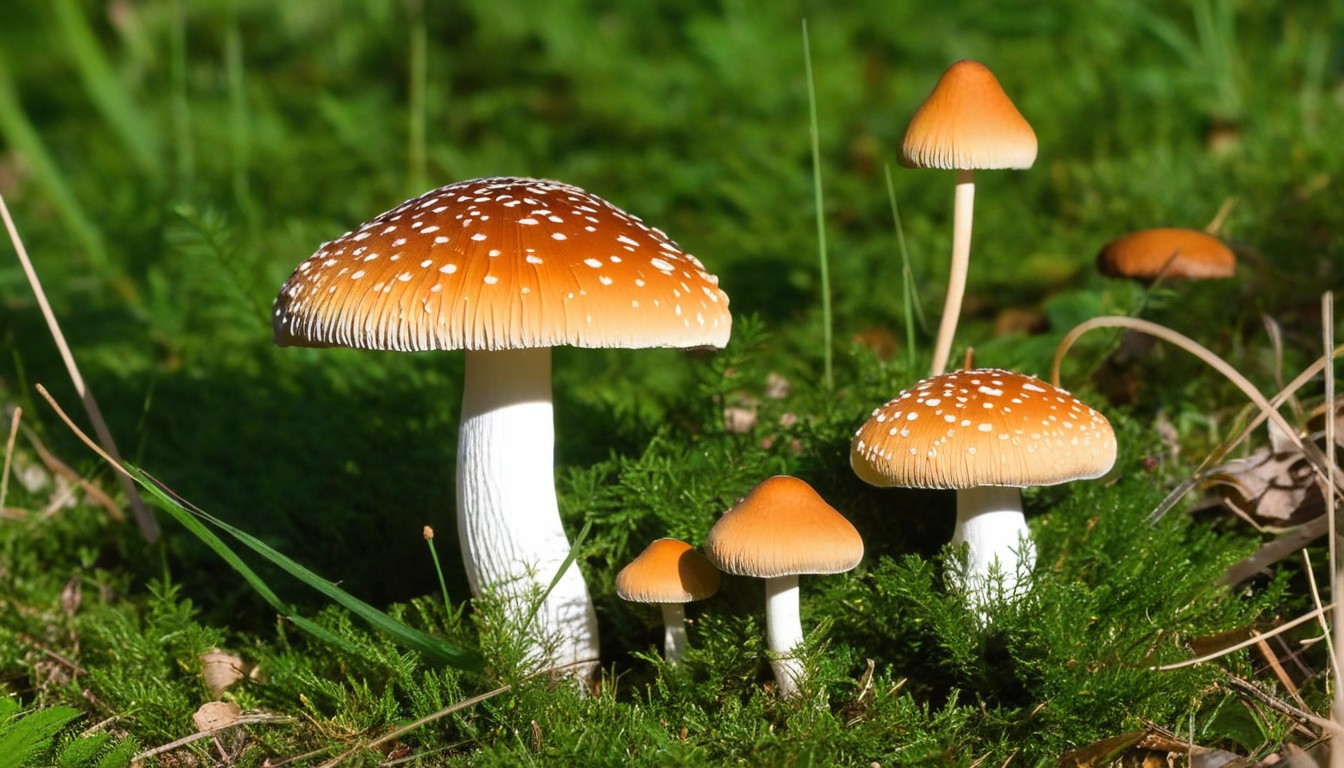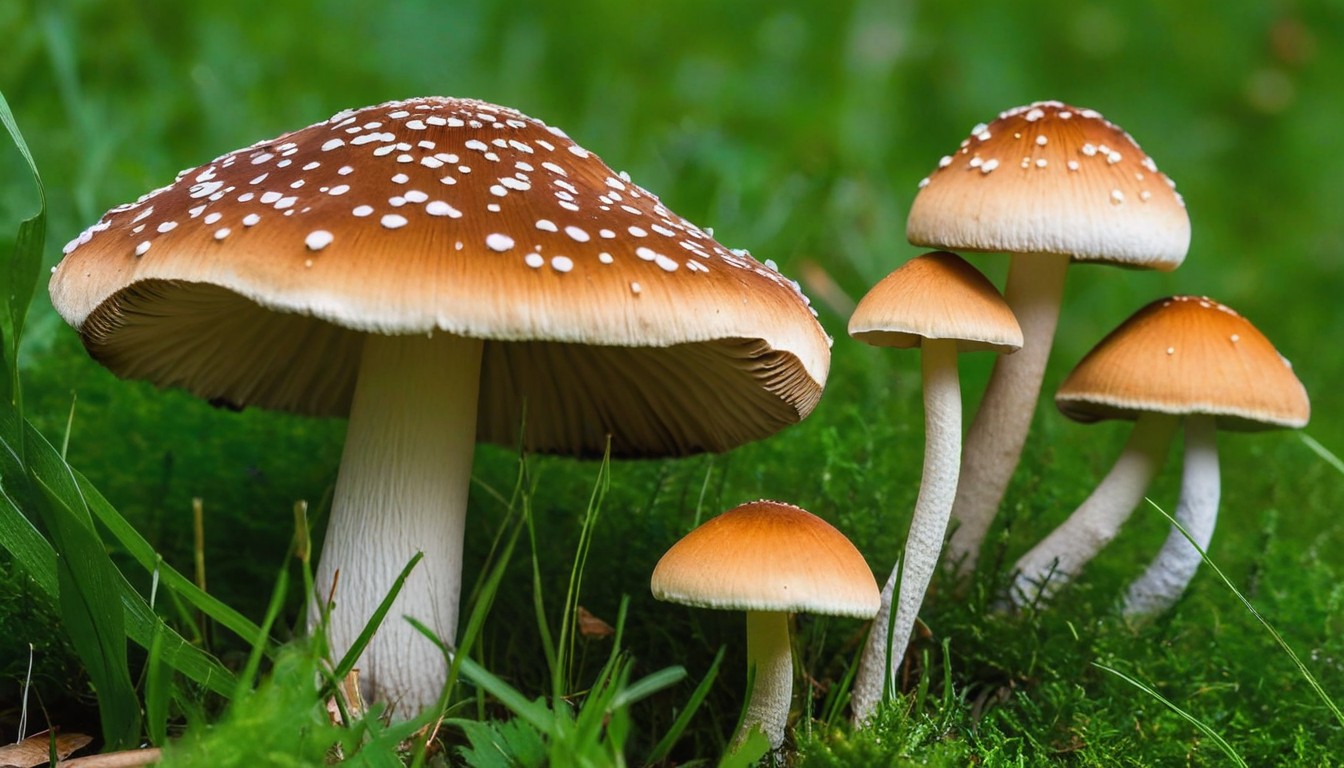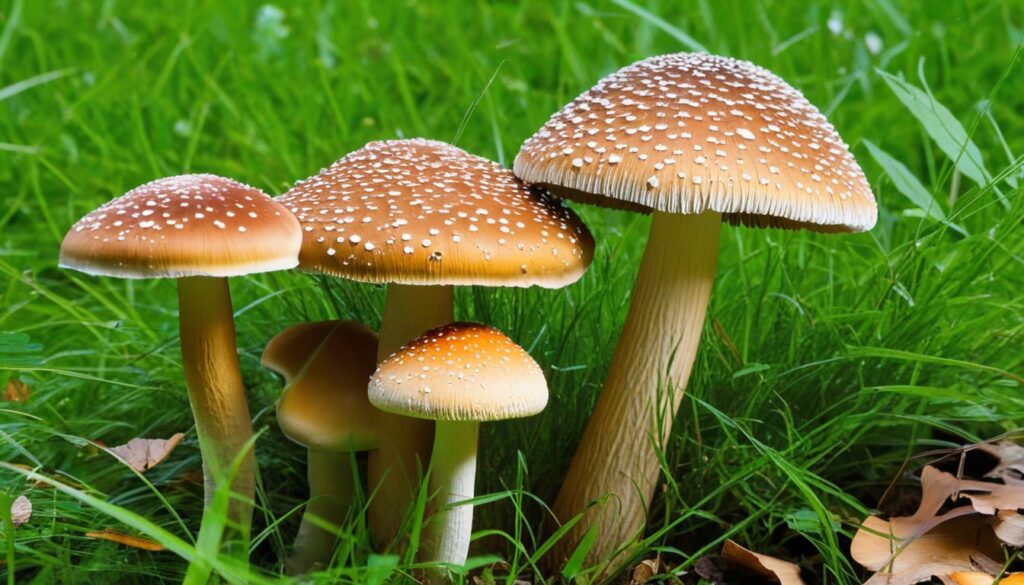Welcome to our article on managing common yard mushrooms in Illinois. If you’re an Illinoisan with a garden, you’ve probably spotted these fungi sprouting up after a rainy day. While they might add a whimsical touch to your garden, some of them can pose risks to your pets or family. That’s why it’s essential to learn how to identify and manage them effectively.
Key Takeaways
- Common yard mushrooms are a frequent occurrence in Illinois gardens.
- Identifying different species is crucial to determine whether they are safe for consumption or pose a potential threat.
- Chemical treatments may be necessary to eliminate growth in some cases, but natural alternatives are also available.
- Prevention is key to keep your garden healthy and prevent future occurrences.
- It’s important to take precautions to avoid mushroom-related risks, especially if you have pets or young children.
Understanding Yard Mushrooms
If you have ever noticed mushrooms growing in your yard, you may wonder what they are and why they are there. Yard mushrooms are part of the fungal kingdom, which plays a vital role in breaking down organic matter and recycling nutrients back into the soil.
Mushrooms are the visible fruiting bodies of fungi, and they appear in your yard when the necessary conditions are met. These conditions include moisture, warmth, and a food source, such as dead plant matter or decaying roots.
It’s essential to understand the nature of yard mushrooms because some varieties can be harmful to humans and pets. By knowing more about these fungi and their role in the ecosystem, you can take the necessary steps to prevent their growth and keep your yard safe and healthy.
Common Yard Mushroom Varieties in Illinois
Illinois is home to a diverse range of common yard mushroom varieties. By learning about their unique characteristics, you can develop a knack for identifying them correctly. Here are some of the most common varieties you might encounter:
|
Mushroom |
Appearance |
Habitat |
|---|---|---|
|
Agaricus |
Medium to large in size, white to brown cap, pinkish gills, tall stem with a ring |
Lawns, gardens, meadows |
|
Amanita |
Medium to large in size, white to brown cap with scales, white gills, long stem with a ring and bulbous base |
Under trees, near shrubs |
|
Boletus |
Medium to large in size, brown to reddish-brown cap, yellowish compact pores, short and stout stem with a reticulated pattern |
Under trees, near shrubs, in forests |
|
Chlorophyllum |
Medium to large in size, brown to grayish-brown cap, white gills, tall stem with a ring |
Lawns, meadows |
|
Lepiota |
Small to medium in size, creamy-white cap with brown scales, free gills, tall stem with a skirt or ring |
Lawns, gardens, meadows |
It’s worth noting that these common yard mushroom varieties vary in terms of edibility and toxicity. Some may be safe to consume, while others can cause severe health problems if ingested. Always exercise caution and avoid consuming any mushrooms unless you are absolutely certain of their safety.
Identifying Common Yard Mushrooms

One of the most crucial steps in effectively managing yard mushrooms is identifying them accurately. Common yard mushrooms in Illinois can be grouped into three categories based on their appearance and characteristics:
Button Mushrooms
These small mushrooms have a rounded cap that is usually beige or brown. They grow in clusters and have delicate white gills underneath the cap.
Webcaps
Webcaps have a cap that is usually reddish-brown, with grooves on the surface. The gills underneath the cap are tightly packed and may be reddish or pinkish in color.
Puffballs
As the name suggests, these mushrooms are roughly spherical and can range in size from tiny to several inches in diameter. They have no visible cap or gills, and the spores mature inside the fruit.
It’s important to remember that some yard mushrooms may have poisonous lookalikes, and that relying solely on appearance is not a foolproof method of identification. Other key factors to consider when identifying common yard mushrooms include their habitat, location, and seasonality.
“When it comes to identifying mushrooms, there is simply no substitute for experience and knowledge.”
In the next section, we’ll discuss how to differentiate between edible and poisonous yard mushrooms and explore potential risks associated with them.
Edible vs. Poisonous Yard Mushrooms
While some mushrooms found in your yard can be a delicious addition to your culinary repertoire, it’s crucial to know the difference between edible and poisonous varieties. Consuming poisonous mushrooms can result in serious health complications, including liver and kidney damage or even death.
One of the most obvious ways to tell whether a yard mushroom is poisonous is by looking at its physical characteristics. Poisonous varieties tend to have bright colors, including red, orange, and yellow. They may also have an unpleasant odor or taste.
On the other hand, edible mushrooms tend to have more subdued colors and a mild, pleasant flavor. Some common edible varieties of yard mushrooms include the giant puffball and chicken of the woods.
If you are unsure whether a yard mushroom is edible or poisonous, it’s best to err on the side of caution and assume it is toxic. Only consume mushrooms that you have correctly identified as safe to eat.
Potential Risks of Yard Mushrooms

While many varieties of yard mushrooms are harmless, some can pose potential risks, particularly if consumed without the proper knowledge. It’s crucial to identify the type of mushroom you are dealing with before ingesting it.
Some of the potential risks associated with yard mushrooms include:
- Stomach upset or indigestion
- Food poisoning-like symptoms
- Allergic reactions such as rashes or hives
- More severe reactions in some individuals, including liver and kidney damage
If you suspect someone has ingested a poisonous mushroom, seek medical assistance immediately. A hospital or poison control center can provide guidance and necessary treatment.
It’s essential to protect yourself and your family from potential mushroom risks. Ensure that children and pets are aware that eating wild mushrooms is unsafe, and remove any lawn mushrooms when they appear to avoid any accidental ingestion.
Remember, it’s better to err on the side of caution, and avoid consuming mushrooms found in your yard unless you’re well-versed in mushroom identification or have consulted with an expert.
Impact on Garden Plants and Soil

Common yard mushrooms can have a significant impact on your garden’s health and soil quality. When mushrooms grow, they form a network of underground filaments called mycelium that absorbs nutrients from the soil and redistributes them to the surface, making them accessible to other plants in the area. This network also breaks down organic matter, making the soil richer and more fertile.
However, certain types of mushrooms can cause harm to garden plants. For example, the honey mushroom can attack and kill trees and shrubs, while the fairy ring mushroom can cause unsightly grass damage. It’s crucial to identify the type of mushroom growing in your yard to understand whether it’s beneficial or harmful.
If you have harmful mushrooms in your garden, it’s essential to control their growth. A dense cluster of mushrooms can prevent air circulation and block sunlight, creating an unhealthy environment for your garden plants. You can manage their spread through regular removal or, if the problem is more widespread, by using natural or chemical treatments to prevent them from returning.
Managing Yard Mushrooms
Yard mushrooms can be a nuisance in your garden and negatively impact your plants and soil. The good news is that they can be managed effectively to prevent overgrowth or eliminate them when necessary. Here are some practical tips to manage yard mushrooms in Illinois:
- Remove them manually: You can physically remove yard mushrooms by hand, ensuring you wear gloves to avoid direct contact, thereby preventing the spread of spores.
- Better watering practices: Over-watering your garden promotes the growth of mushrooms. Therefore, proper watering practices, ensuring plants have adequate drainage, can prevent their emergence.
- Improve air circulation: Yard mushrooms thrive in damp environments. By improving air circulation in your garden, moisture levels are reduced, limiting their growth.
- Maintain soil pH levels: Testing your soil regularly and maintaining a pH level of 6.5 to 7 can discourage the growth of yard mushrooms.
- Apply natural fungicides: Eco-friendly fungicides such as baking soda or a diluted vinegar solution can help prevent the growth of yard mushrooms.
- Consider chemical treatments: In severe cases of yard mushroom overgrowth, chemical treatments may be necessary. However, always consult a professional and use products safely following the instructions.
By implementing these management strategies, you can effectively prevent or eliminate yard mushrooms from your garden. Remember, identifying them accurately and understanding their nature are the first steps to effective management.
Natural Approaches for Mushroom Control

If you’re looking for an environmentally friendly way to control the presence of yard mushrooms in your garden, there are several natural approaches you can use.
1. Remove Mushroom Habitat
One of the simplest ways to control mushroom growth is by removing their habitat. Yard mushrooms typically thrive in humid conditions with organic matter, such as decaying leaves or mulch. By reducing the amount of organic matter in your garden and improving drainage, you can help prevent mushrooms from growing.
2. Increase Sunlight
Mushrooms prefer shady, damp areas, so increasing sunlight in your garden can help reduce their growth. Trim back trees and shrubs that block sunlight and avoid overwatering your garden.
3. Vinegar Solution
An effective natural fungicide for reducing mushroom growth is a vinegar solution. Mix a quarter cup of white vinegar with a quart of water and spray the mixture directly on the mushrooms.
4. Coffee Grounds
Used coffee grounds can also help control mushroom growth in your garden. Simply sprinkle the grounds around the areas where mushrooms tend to grow, and they will act as a natural fungicide.
With these natural approaches for mushroom control, you can effectively manage the presence of mushrooms in your garden without harming the environment or your plants.
Chemical Treatments for Yard Mushrooms
In some instances, natural approaches to managing yard mushrooms may not be enough, and chemical treatments may be needed to prevent their growth. Chemical treatments include the use of fungicides that are designed to target and prevent fungal growth in your garden.
Types of Fungicides
There are two primary types of fungicides you can use to manage yard mushrooms in your garden:
- Contact Fungicides – These products are applied directly to the affected mushrooms and work by inhibiting fungal growth on the surface of the mushroom.
- Systemic Fungicides – These products work by being absorbed by the plant and traveling throughout the plant’s system, inhibiting fungal growth from the inside out. Systemic fungicides not only kill mushrooms but also prevent their return.
Using Fungicides Safely
When using fungicides to manage yard mushrooms, it’s essential to follow safety instructions to minimize risk. Always wear personal protective equipment such as gloves and a respirator when applying fungicides, and keep children and pets away from the affected area until the fungicide has dried completely.
Long-Term Prevention Strategies
While managing yard mushrooms is critical, preventing their reappearance is equally important. By implementing long-term prevention strategies, you can create an environment less conducive to their growth. Here are some effective techniques:
- Remove decaying matter: Yard mushrooms thrive on decomposing organic materials. By removing dead leaves, twigs, and other debris from your garden, you eliminate their food source and create an inhospitable environment for their growth.
- Improve drainage: Poor drainage can lead to waterlogging, which is a breeding ground for mushrooms. Consider installing drainage systems to prevent excess water from accumulating in your garden.
- Modify watering habits: Since mushrooms grow best in moist conditions, it’s crucial to reduce watering frequency. Water your plants only when necessary and avoid overwatering.
- Aerate soil: Aerating your garden soil can help improve drainage and reduce moisture, making it less favorable for mushroom growth.
- Use mulch carefully: Mulch can retain moisture and promote fungal growth. Limit the use of mulch and avoid over-applying it in your garden.
By following these long-term prevention strategies, you can minimize the chances of yard mushrooms reappearing and keep your garden healthy and beautiful.
Conclusion
Managing yard mushrooms in your Illinois garden may seem daunting, but with the right knowledge and strategies, it can be easily achieved. Remember to first understand the nature of yard mushrooms and their role in the ecosystem. By identifying the different varieties and distinguishing between edible and poisonous mushrooms, you can ensure the safety of yourself and your loved ones.
When it comes to managing yard mushrooms, there are both natural and chemical methods to choose from. Eco-friendly approaches such as removing excess organic matter and improving drainage can be effective in preventing and controlling mushroom growth. Chemical treatments may also be necessary in some cases, but be sure to use them safely and as a last resort.
Finally, implementing long-term prevention strategies such as proper watering and soil management can help minimize the recurrence of yard mushrooms. By following these steps and being proactive in managing yard mushrooms, you can maintain a beautiful and safe garden for years to come.
FAQ
What are yard mushrooms?
Yard mushrooms are a type of fungi that commonly appear in Illinois yards. They are the fruiting bodies of underground fungi, and their purpose is to release spores for reproduction.
Why do yard mushrooms appear in Illinois yards?
Yard mushrooms appear in Illinois yards due to the presence of organic matter such as decaying tree roots, dead leaves, or buried wood. These mushrooms help break down this organic matter and contribute to the natural ecosystem.
How can I identify common yard mushroom varieties in Illinois?
To identify common yard mushroom varieties in Illinois, look for distinguishing features such as cap color, shape, gill structure, and stem characteristics. It’s important to note that some varieties may require microscopic examination for accurate identification.
What are the potential risks of consuming yard mushrooms?
Consuming yard mushrooms without proper knowledge can pose potential risks. Some varieties may be poisonous and cause adverse reactions or even be fatal. To avoid these risks, it’s best to avoid consuming yard mushrooms unless you are confident in their identification.
How do yard mushrooms impact garden plants and soil?
Yard mushrooms can have both positive and negative effects on garden plants and soil. They help break down organic matter and release nutrients into the soil, benefiting plant growth. However, some varieties can compete with plants for nutrients or release compounds that inhibit plant growth.
What are some natural approaches for controlling yard mushrooms?
There are several natural approaches for controlling yard mushrooms. These include improving soil drainage, removing decaying organic matter, and promoting healthy plant growth. Additionally, adjusting watering practices and using organic mulches can help create an environment less favorable for mushroom growth.
When should I consider using chemical treatments for yard mushrooms?
Chemical treatments for yard mushrooms should be considered when natural methods are ineffective or when the mushroom presence poses a significant problem. It’s important to follow the instructions on the fungicide label and take necessary precautions when using chemical treatments.
What are some long-term prevention strategies for yard mushrooms?
To prevent the recurrence of yard mushrooms in the long term, focus on maintaining a well-drained soil, removing decaying organic matter regularly, and promoting healthy plant growth. Proper watering and mulching practices can also help create a less favorable environment for mushroom growth.

